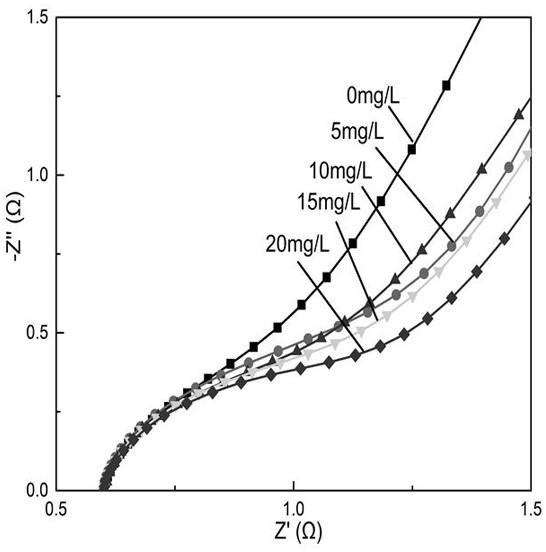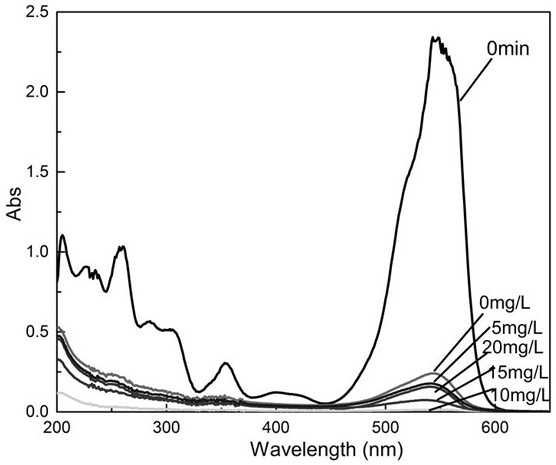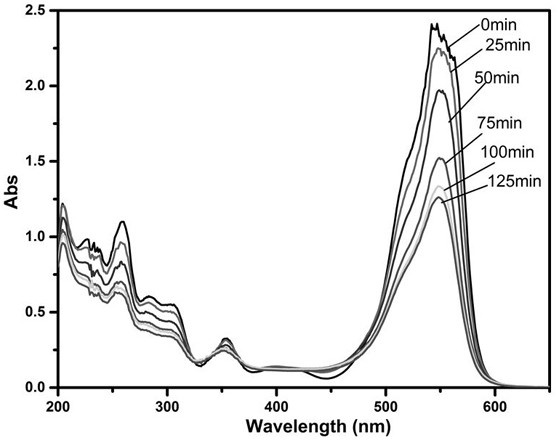A kind of preparation method and application of ruthenium oxide-antimony trioxide/carbon nanotube electrode material
An electrode material, thermal oxidation technology, applied in metal/metal oxide/metal hydroxide catalysts, chemical instruments and methods, chemical/physical processes, etc. The effect of promoting absorption, improving efficiency, and efficient synergy
- Summary
- Abstract
- Description
- Claims
- Application Information
AI Technical Summary
Problems solved by technology
Method used
Image
Examples
Embodiment 1
[0029] a RuO 2 -Sb 2 o 3 The preparation and application of electrodes as photoelectrocatalytic materials includes the following steps:
[0030] (1) prepare 1mol / L antimony trichloride ethanol solution and 1mol / L ruthenium trichloride (containing ruthenium is 37wt%) ethanol solution, the two are mixed by molar ratio Ru:Sb=1:9.7 ultrasonic 10min; Then add ammonia water for titration, adjust the mixed solution to pH=8;
[0031] (2) Heat and stir the prepared mixed solution in a water bath at 80°C; then pour it into a hydrothermal reaction kettle and react at 100°C for 24 h, then put it into a centrifuge for centrifugation, take it out and wash it with ethanol and distilled water respectively The precipitate was filtered and washed, dried in an oven at 80°C for 12 h, and the mixed powder was obtained after grinding;
[0032](3) Dissolving the solid mixed powder obtained in step (2) in an ethanol solution to prepare a solution with a total concentration of Ru and Sb of 1 mol / L...
Embodiment 2
[0036] a RuO 2 -Sb 2 o 3 The preparation and application of / CNTs electrodes as photoelectrocatalytic materials include the following steps:
[0037] (1) prepare 1mol / L antimony trichloride ethanol solution and 1mol / L ruthenium trichloride (containing ruthenium is 37wt%) ethanol solution, the two are mixed by molar ratio Ru:Sb=1:9.7 ultrasonic 10min; Then add ammonia water for titration, adjust the mixed solution to pH=8;
[0038] (2) Heat and stir the prepared mixed solution in a water bath at 80°C; then pour it into a hydrothermal reaction kettle and react at 100°C for 24 h, then put it into a centrifuge for centrifugation, take it out and wash it with ethanol and distilled water respectively The precipitate was filtered and washed, dried in an oven at 80°C for 12 h, and the mixed powder was obtained after grinding;
[0039] (3) Dissolve the solid mixed powder obtained in step (2) in an ethanol solution, and prepare a solution with a total concentration of Ru and Sb of 1...
Embodiment 3
[0043] a RuO 2 -Sb 2 o 3 The preparation and application of / CNTs electrodes as photoelectrocatalytic materials include the following steps:
[0044] (1) prepare 1mol / L antimony trichloride ethanol solution and 1mol / L ruthenium trichloride (containing ruthenium is 37wt%) ethanol solution, the two are mixed by molar ratio Ru:Sb=1:9.7 ultrasonic 10min; Then add ammonia water for titration, adjust the mixed solution to pH=8;
[0045] (2) Heat and stir the prepared mixed solution in a water bath at 80°C; then pour it into a hydrothermal reaction kettle and react at 100°C for 24 h, then put it into a centrifuge for centrifugation, take it out and wash it with ethanol and distilled water respectively The precipitate was filtered and washed, dried in an oven at 80°C for 12 h, and the mixed powder was obtained after grinding;
[0046] (3) Dissolve the solid mixed powder obtained in step (2) in an ethanol solution, and prepare a solution with a total concentration of Ru and Sb of 1...
PUM
| Property | Measurement | Unit |
|---|---|---|
| concentration | aaaaa | aaaaa |
Abstract
Description
Claims
Application Information
 Login to View More
Login to View More - R&D
- Intellectual Property
- Life Sciences
- Materials
- Tech Scout
- Unparalleled Data Quality
- Higher Quality Content
- 60% Fewer Hallucinations
Browse by: Latest US Patents, China's latest patents, Technical Efficacy Thesaurus, Application Domain, Technology Topic, Popular Technical Reports.
© 2025 PatSnap. All rights reserved.Legal|Privacy policy|Modern Slavery Act Transparency Statement|Sitemap|About US| Contact US: help@patsnap.com



